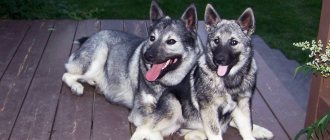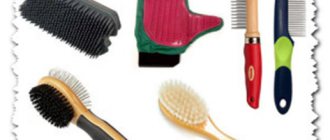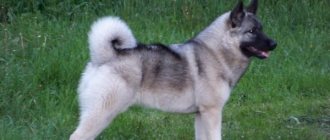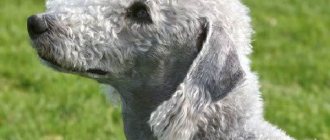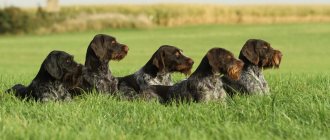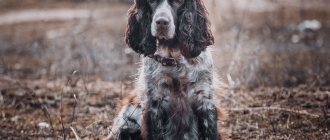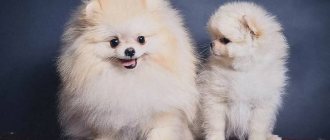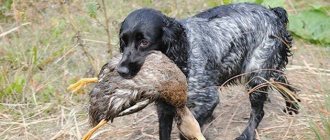The Norwegian Elkhound is a northern Spitz-type dog breed used primarily for moose hunting. Recognized as the national breed of Norway. A wonderful family dog, a companion, strongly attached to family members and the owner, but at the same time remains independent and independent. Hardy and very viscous in work. Also suitable for hunting other large and small animals. Norwegian Elkhounds come in gray and black colors, they are very similar in appearance and character, but are considered separate breeds, each with its own standard.
- 2 Appearance
- 3 Character and behavior
- 4 Education and training
- 5 Contents 5.1 Care
- 7.1 Price
- 8.1 Video about the dog breed Norwegian Elkhound (Norwegian Elkhound)
History of the breed
The ancestors of the Norwegian dog are considered to be pets that lived in Scandinavia 5-7 thousand years ago. Archaeologists have discovered the fossilized remains of these dogs in Viking burials.
The height at the withers of dogs is 49-52 cm
To understand which country the Elkhound comes from, you need to look at the name of the breed. These dogs are the national symbol of Norway and have a long history. At the moment, the exact year of origin of the elkhound is unknown. However, for the first time representatives of the breed were shown at an exhibition in 1877. Since 1962, Norwegian dog breeds have been officially recognized by the Federation Cynologique Internationale.
There are many variations of the name of the breed: gray husky, Norwegian Elkhuand, Viking dog. Literally translated, the official name sounds like “elk dog.” This nickname appeared due to the dog’s ability to hunt large animals, including moose.
Appearance description
As a rule, the Elkhound is quite large, it grows up to 50 centimeters at the withers, it can weigh from 20 to 25 kilograms, girls are slightly smaller. The dog is proportionally built and has a very similar appearance to the husky, which is why it is also called that. The muzzle is quite cute, without rough features. The head is rounded and has triangular ears that are very movable. The paws are powerful, with fairly wide but neat feet, which allow them to easily overcome snow cover and long distances. The chest is wide, the tail is held in a ring, like all huskies.
Unique Specialization
Despite the name (elghund from elg elk and hund dog), the Norwegian husky elkhound is quite versatile and immensely talented: fearless and very powerful dogs, in addition to baiting large animals, perfectly perform the weapon complex against small game and all types of birds (search/flying/finishing wounded animals/apportation). Large individuals willingly work in harness and demonstrate excellent performance in guard and guard disciplines.
They are smart, friendly and well-coordinated animals: Norwegian Elkhounds make great family dogs, companion dogs, and family dogs.
Purpose
The main purpose for which the Norwegian Blue and Black Elkhound dog breed was intended was hunting for large moose and other animals. They are ideal for hunting these artiodactyls, as they have special tactics. Thanks to its sensitive sense of smell, the dog finds the animal and holds it with a sonorous bark until the owner arrives.
This is why Norwegian Elkhounds are preferred by avid big game hunters. In addition to their hunting abilities, such dogs are excellent for living with humans.
Characteristics and description of the breed
East Siberian Laika: description of the breed
The Norwegian Husky is a northern dog that has an independent character. Elkhounds are adapted to survive in harsh conditions, but at the same time they are friendly and loyal to their owner.
Benefits of huskies:
- sociability;
- intelligence and intelligence;
- attachment to the owner;
- treats strangers with caution;
- gets along well with children;
- guard and hunting qualities.
Disadvantages of the breed:
- barks a lot and reacts sharply to all noises;
- independence;
- due to improper upbringing, it can dominate the owner;
- requires regular training and physical activity.
The coat color of the elk husky is gray, with black tips at the tips of the hairs. The undercoat is usually a light gray shade. There is a black mask on the face, and the ears are also black. The advantage is a dark smooth line from the eyes to the ears.
A purebred dog should not have white spots on its body
Description of the breed:
- the body is muscular and large, with a straight, strong back;
- ribs strongly curved and voluminous;
- the head is wedge-shaped, widening towards the muzzle;
- the ears are small, set high, pointed at the ends and mobile;
- nose is black;
- eyes are medium and oval, always dark brown;
- thick tail curled into a ring.
Interesting! The Norwegian is an excellent hunter of small and large prey. He can track the animal for hours, and then, having driven it into a dead end, proceed to attack. Elkhounds have a well-developed sense of smell, so they can sense other animals several kilometers away.
Buhund care
Norwegian Shepherds are unpretentious dogs; for them, conscientious fulfillment of basic care responsibilities by the owner is sufficient.
Conditions of detention
Due to their medium size, Norwegian Buhunds can be comfortably kept both in apartments and in private homes. Due to the characteristics of the coat and the place of origin of the breed, representatives are often kept not indoors, but in outdoor enclosures, where they feel great. However, in order for the dog not to lose its energy, time with it must be spent actively. Walks (regardless of the type of content) should be daily, at least 1–2 hours with active games and moderate physical activity. Lack of sufficient activity will cause destructive behavior and animal protest.
General care
There are no special features in keeping buhunds; the owner only needs to carry out all the standard procedures:
- comb the coat 1-2 times a week and daily during shedding;
- bathe as needed;
- clean your ears when they become dirty (inspection for such a need should be done once a week);
- brush your teeth;
- Trim nails as they grow.
When properly cared for, Norwegian Shepherds do not have an unpleasant dog odor.
Nutrition
Feeding Norwegian Shepherds requires following basic rules of a healthy diet. On a natural diet, a dog should receive:
- fresh meat (beef, chicken, rabbit, turkey);
- low-fat fermented milk products, in particular cottage cheese;
- valuable by-products (heart, liver);
- plant products (unsweetened fruits, vegetables, herbs);
- cereals (only rice, buckwheat and oatmeal are allowed).
It is better to completely avoid bread and other baked goods, sweets, and seasonings in your dog’s diet.
If we talk about industrial diets, then only super-premium and holistic class products will be truly high-quality. For Buhunds, the best choice is food for medium-sized dogs with increased activity (Royal Canin Medium Adult, Hills Adult Medium, Brit Care Adult Endurance Duck & Rice for adult active dogs, etc.).
For Buhunds, food for medium-sized breeds is suitable, for example Royal Canin Medium Adult
Training
By nature, Buhunds are endowed with curiosity and a lively mind; they easily learn new knowledge and commands. Therefore, you can teach your dog the basics of behavior and obedience even without professional help. Socialization is also necessary - this will allow the dog to adequately relate to other animals and people, without going too far with suspicion. One of the main problems that will have to be dealt with during training is the excessive barking that is characteristic of the breed.
Wool
The Norwegian Elkhound has a luxurious coat, typical of northern dogs - gray, coarse hair with a light silvery soft undercoat. Such a cover is not afraid of any bad weather. There is a lush woolen collar on the animal’s neck. On the face, tip of the tail and ears the coat color is almost black.
The color of this breed resembles the coat of a wolf - gray wool with a light gray undercoat. The animal's fur requires special attention during shedding, which occurs seasonally; it is very active. The Norwegian Elkhound requires weekly brushing and combing with a special brush, which helps to minimize free hair loss.
Since this dog cleans itself naturally, it should only be bathed when absolutely necessary.
Activity
The Norwegian Elkhound is not a breed that is suitable for living in an apartment. She needs physical activity and a large space, so it is best if the animal has a large fenced yard at its disposal. The dog will feel great on a farm, where he will have a lot of familiar work.
The Elkhound is a wonderful companion. Dogs of this breed have proven themselves well in protection, they are excellent watchmen, they herd livestock very skillfully, and when harnessed to a sleigh, they can transport loads.
Due to the thick, fleecy undercoat, the dog can hardly tolerate the heat, and on frosty winter days and even in inclement and rainy weather, it feels very comfortable. On summer days, the Elkhound loves to swim and hides from the sun's rays in a shady place.
Disadvantages and disqualifying vices
Karelo Finnish Laika: description of the dog breed
The Norwegian Elk Husky does not always meet breed standards. There are a number of defects, the presence of which can disqualify a dog and not allow it to compete. These signs include:
- disproportionate shape of the skull;
- too short or sharp shape of the muzzle;
- presence of a bite other than a scissor bite;
- light eyes;
- ears that are too large, droopy and wide;
- insufficiently curled or short tail;
- coat color different from the standard;
- the presence of additional toes on the hind legs;
- aggressive behavior.
Prices
The price for the Laika breed is low. Even a purebred husky can be purchased at a price lower than that of representatives of other hunting breeds, however, you should only purchase a puppy from trusted breeders.
The price for a baby without a metric can range from 5,000 to 7,000 rubles. This is an excellent option for people who do not plan to breed the breed or exhibit them at Russian or international exhibitions.
A top-class purebred husky costs from 10,000 rubles and above. However, such a high price is determined not only by the exterior, which is as close as possible to the ideal and the purity of the pedigree, but also by the merits of the manufacturer and the fame of the nursery.
So how much does a like cost? The cost of an adult hunting husky depends on the size of the animal it can hunt. Compare:
- “squirrel breeds” from trusted breeders cost 5000-7000,
- “sablehouses” – 7000-9000,
- large game hunters – from 10,000 rubles.
Kennels sell vaccinated and healthy puppies with good pedigree, from working champion parents. However, for many future owners, purebred is not important, so they turn to private sellers, whose puppies are much cheaper. For this reason, there are not many nurseries specializing in breeding huskies.
Exterior Features
The Buhund, or Norwegian Shepherd, is a strong, compact, square dog. On the dry, pointed head are dark, small eyes and pointed, erect ears. The massive short neck of this breed smoothly flows into a strong, well-defined withers and straight back.
The dog has a dense, muscular body with a deep chest and tucked belly. Under the harmoniously built body there are dry and strong limbs with oval paws. The dog's high-set short tail is curled into a ring and laid on its back. The height of an adult animal ranges from 41 to 47 centimeters. At the same time, the Norwegian Buhund weighs on average 12-18 kilograms.
Representatives of this breed are covered with thick, hard, tight-fitting hair. The wheat color of the animals varies from light cream to a reddish hue. The standard allows for a dark mask and the same tips of guard hairs.
Appearance
The Norwegian Elkhound is a typical Spitz with a compact short body, erect ears, thick, abundant hair and a tail curled over the back. Sexual dimorphism is well expressed. Height at withers:
- Gray elk husky - 49-52 cm;
- Black moose husky - 43-49 cm.
The skull is wedge-shaped, relatively flat between the ears. The cheekbones are prominent. Stop is expressed moderately. The muzzle tapers gradually towards the black nose. The bridge of the nose is straight. The lips fit well. Scissor bite. The eyes are dark brown, non-protruding. The ears are set straight and high, small, pointed, very mobile. The width of the ears at the base is slightly less than the height.
The body is strong and durable. The topline is straight. The withers are well developed. The back is straight and strong. The croup is wide and strong. The chest is deep, wide, with curved ribs. The underline is almost straight. The tail is set high and relatively short. Screws tightly and sits on the center line of the top without leaning to any side. The legs are strong, strong, straight, and dry. The paws are relatively small, compact, with well-knit and forward-pointing toes.
Black and gray Norwegian Elkhounds look very similar, however they are two different breeds. The black moose husky has a tougher disposition, its coat is shorter, its size is smaller, its body is lighter and less compact.
The coat is medium length, coarse, thick. The guard hair is abundant, without curls. On the front side of the legs and head the hair is smooth and short. Long on the neck, back of the limbs, hips, and tail. The undercoat is soft and dense. Color:
- The gray Elkhound has various shades of gray. Guard hairs with black tips. On the chest, belly, legs, lower part of the tail, under the tail, and on the harness-shaped body, the hair is lighter. From the withers to the elbows, the top of the tail is darkest. The ears and the front of the head (mask) are also dark. A dark line runs from the eyes to the base of the ears. The undercoat is always light gray.
- The black Elkhound has a glossy black color. Small white markings on chest and paws are allowed.
Pet character
Yakut Laika: characteristics of the dog breed
The Scandinavian Elkhound is a balanced and friendly dog. He is fearless, but does not allow himself to be overly aggressive. Tries to show a good attitude towards everyone around him, but if necessary, he can protect himself and his owner. From the first days in the house, the dog understands who its owner is, quickly becomes attached to the person and becomes a true friend. These pets exhibit all the qualities of a companion dog and love all family members, including children.
Interesting! The Norwegian Black Elkhound differs from the Gray Husky in its energetic character, while the Elk Dog is calmer and more flexible.
If there are other pets in the house, difficulties may arise. The dog is accustomed to being a leader and therefore is jealous of other animals nearby, especially if a person pays a lot of attention to them. If you want to have several pets at once, it is recommended to take them at the same time as the Elkhound puppy. When the kids grow up together, it will be easier for them to find a common language.
Owner reviews
The owners of Norwegian Laikas are unanimous in their opinion about their pets:
- Elkhounds are receptive to training and at a fairly young age are already ready to work in difficult conditions: by 8–10 months, a properly socialized puppy that has acquired its first hunting skills can be taken by a hunter;
First lessons for future hunters
- representatives of the breed have developed intelligence; when working with animals, they are able to act intuitively, without waiting for the owner’s command;
- these are ideal assistants in hunting large animals - elk, wild boar and even bear: Elkhounds do not show excessive anger, they act carefully but viscously, holding the game in place, which gives the hunter the opportunity to calmly approach it;
Training a young Elkhound on a bear
- Norwegian huskies have an excellent sense of smell, a good search and a ringing, informative voice that is clearly audible from afar. These dogs combine unpretentiousness with extraordinary endurance, which allows them to pursue and hold an animal for a long time.
Elkhound and his big prey
However, you need to be aware of some points that may be difficult for the owner of a Norwegian Husky:
- high price of a puppy: its cost starts from 700 and can reach 1500 Euros;
- difficulties in processing documents in RORS;
About the “Hunting Dog Certificate” of a single sample
- in connection with the rare certification tests of Norwegian Laikas carried out by the RFOS and the RKF, it becomes necessary to take the dog for testing abroad;
- the small distribution area in Russia of elk, the main object of hunting with the Norwegian husky, as well as the high cost of a shooting license.
However, all these difficulties are compensated by the fact that the Norwegian elk husky is a passionate and unsurpassed hunter, an excellent companion and intelligent assistant, a devoted and reliable friend.
Summing up
The national treasure and symbol of Norway, the Laika Elkhound is an ideal hunting dog. Natural beauty, flexible character and rare working talents bring the breed to the forefront of commercial Spitz-like animals. When thinking about purchasing a Norwegian masterpiece, you need to clearly understand: the breed is difficult to support and educate, and requires a huge investment of personal time, effort and finances.
- Laika
If you find an error, please select a piece of text and press Ctrl + Enter.
Education and training
Although the Norwegian Gray Elkhound has high intellectual abilities, it is usually difficult to train. If a dog gets bored during training, it begins to ignore its owner and get distracted by its own business. Since pets are intended for protection, they must be raised from childhood. Otherwise, the dog will grow up with an uncontrollable character. Due to their stubborn nature, training can take a long time and it will take much more time to train one team. The owner must remember not to give in to the dog and follow its lead. Perseverance and determination on the part of a person will help achieve their goals. From the first walks, the puppy should become acquainted with other dogs, undergoing socialization.
Note! During training, you must not be rude or cruel to the dog.
Every owner should reward the dog for following a command.
Types and their characteristic differences
All dog breeds are divided according to different criteria for their purpose. There are service or guard ones. Laikas are considered sled dogs.
Since ancient times, sledding huskies have been used mainly in the far north for moving across snowy expanses and transporting goods.
Now, with the advent of new means of transportation, the need for them has decreased significantly, but they are still used in various competitions, as hunters and guards.
There are many breeds of sled huskies, but the most common are:
- samoyed huskies (samoyeds);
- Alaskan Malamute;
- Siberian sled dog (husky).
There are also Chukchi, Eskimo, and Kamchatka Laikas.
Samoyeds are very energetic, quite persistent and strong, of medium size, with a powerful head, dense and widely spaced ears.
They look like a fluff ball and are distinguished by densely growing fur. The legs and tail are strongly drooping. They are friendly, playful, easy to train, make good contact, and have a hard time parting with their owner.
Malamutes are widely used in Alaska not only for harnessing, but also for seal and bear hunting. Widespread in Russia.
They differ from Samoyeds in the proportionality of the head in relation to the body, a softer appearance, a large muzzle, medium ears, large paws, and a flat back. The tail is at a medium level, curls, but does not form a ring.
Most often this breed has a light gray color, white spots on the face, and a white tail in some places.
They are very kind by temperament, love attention, have well-developed muscles, are trainable, but sometimes have a stubborn character.
Huskies are very similar to Malamutes, only a little faster and are not able to carry large and heavy loads. They are distinguished by their gracefulness, narrower skull and canonical muzzle shape.
The ears are set high and directed forward. The eyes are either brown or blue, but can be a variety of colors. The color may be the same, but the husky is not as fluffy and weighs lighter than the malamute.
These dogs respond well to children, but require special care, attention and regular training.
Laika has long been used for hunting. Based on the character of a young dog, you can immediately determine who it will be as an adult.
Some immediately begin to hunt small game, others large animals. There are universal huskies that hunt both, but they are extremely rare.
They are taught to hunt small animals at the age of six months, and to hunt large animals from the age of 2 years.
A real animal husky will not be distracted by birds and small fur-bearing animals, but will direct all its attention to large prey. He navigates the area well and will never lose his owner in the taiga
Distinctive features of the beast husky:
- large growth;
- fast run;
- endurance;
- powerful voice;
- good sense of smell;
- passion for hunting.
To summarize, it is important to understand that the Laika is a breed of dog that requires a lot of attention, time, responsibility, physical and material costs. The future owner must calculate his capabilities for its maintenance and proper care
The future owner must calculate his capabilities for its maintenance and proper care.
By qualitatively fulfilling all the living conditions for a Laika, he will receive not only an assistant in his business, but a devoted friend for many years of life together.
Training a commercial husky
Upon successful completion of socialization, education and training courses, the time comes for hunting practice. Training a game dog is a responsible and very difficult job. Experienced game wardens and rangers train young Norwegian moose hunters in equipped areas with the help of older and more experienced hunting dogs. During training sessions, the hunting conditions of young animals (voice, viscosity, passion) are assessed and gentle training is carried out. Norwegian Elkhounds get used to gun shots and become familiar with the techniques of tracking and baiting large game.
Dogs are attracted to “serious” hunting when they reach the age of two. Until this moment, the young animals are taken “to the field”, but are not allowed to participate in the hunt, only showing the carcasses of killed animals to the young dogs.
How to properly care for a Norwegian Elkhound
When choosing this breed, you should remember that Norwegians do not tolerate heat. Winter frosts and rainy days are optimal for them. During the hot season, it is necessary to keep the dog in the shade and not limit access to water. These dogs love to swim.
The coat should be cleaned every week using a small comb or brush. It is necessary to examine the animal's ears and eyes daily. Otherwise, Elkhounds are unpretentious and do not require special conditions.
Note! It is not advisable to keep dogs in an apartment. In such a space there is little space for dogs, and reduced activity is harmful to their health.
How to choose a puppy
When choosing a puppy, you should first of all talk with the owner of the kennel, look at the parents of the babies, and study their pedigree.
Signs of a healthy puppy include:
- shiny wool;
- eyes without oxides;
- absence of unpleasant odors;
- liveliness of sight;
- wet nose;
- correct bite;
- playful attitude and curiosity.
Note! Large nurseries can facilitate the delivery of a puppy to any country after payment is made.
What to feed
The Norwegian elkhound is one of the most unpretentious dogs. Owners must decide for themselves which food to choose for their pet - ready-made or natural, based on their capabilities. If the choice is on dry food, then its class should be “premium”, “holistic” or “super-premium”. These products are manufactured based on the physiological needs of large dogs and contain all the necessary substances.
When choosing natural food, you should keep in mind that the bulk of the diet should be lean meat and offal. You are allowed to add sea fish to your food 3 times a week. Be sure to include vegetables and grains in your diet. Once every 2 weeks you can give your pet kefir or cottage cheese.
Note! Elkhounds are prone to obesity, so it is necessary to monitor portion sizes and avoid overeating.
Care and hygiene
Elkhounds are quite clean, so grooming the dogs is not difficult. Their coat has two layers - a guard hair of a hard texture and a softer, but rather dense fleecy undercoat. Grooming usually consists of weekly combing and brushing. During periods of seasonal molting, the procedure is carried out more often to avoid the formation of tangles. In spring and summer, after each walk, it is necessary to examine the dog for ticks.
Items for combing wool
An Elkhound should only be bathed when it is very heavily or extensively soiled. In general, the coat of the Norwegian Husky cleans itself well when walking through tall, dewy grass or deep snow.
Important! The advantage and peculiarity of the Elkhound is that the dog does not have the characteristic unpleasant dog odor.
Eyes and ears are cleaned as needed. In the absence of dark or cloudy discharge from the eyes and plaque on the inner surface of the ears, caring for these areas boils down to wiping them once a week with a special zoo lotion or a damp cloth.
Clear eyes, clean ears, shiny coat - indicators of good health of the Elkhound
Scandinavian diets
The Norwegian husky is undemanding in matters of nutrition: like all representatives of the commercial Spitz family, moose huskies are absolutely omnivorous. This is the result of the current way of life: hunting dogs have never been pampered with an exquisite menu and an abundance of portions. Laikas were always fed only when working “in the field,” using classic yukola (dried fish meat) as the main food.
Modern dogs are fed better quality and more varied; a meager and primitive diet has a negative impact on the health, working conditions and appearance of the pet.
The optimal choice for the daily nutrition of hunting dogs is industrially prepared ready-made diets and elite-class wet canned food. This is a professional formula: balance and saturation with everything necessary for life, a wide range and amazing practicality. The “super premium” and “holistic” food items take into account the age characteristics and physiological status of the dog, and contain, in addition to nutrients, all vitamin and mineral supplements.
The diet should be adjusted depending on the time of year and the activity of the animal:
- to compensate for energy costs in the cold season, you need to focus on feed with a high content of proteins and fats;
- the volume of a single serving should not exceed three percent of the dog’s weight;
- when going fishing and participating in competitions, the amount of food (calorie content of the diet) increases by a third.
An adult Norwegian Husky is fed twice a day. Regardless of the food format, the dog should always have free access to drinking water.
Contents of the Norwegian Husky
The Norwegian Elkhound is an active dog with a lively, inquisitive character. Limiting the area where the husky is forced to move little has a negative impact on its health and working qualities. Therefore, it is highly not recommended to keep a Norwegian Elkhound in a city apartment. The best option for providing living space for a pet is to set up an enclosure with a booth on a spacious fenced-in plot.
In the fenced space of the enclosure it is easy to control the safety of puppies
Growing young animals and adults should not be kept on a leash. The Norwegian Laika is one of those breeds in which a sharp restriction of freedom provokes the development of various diseases and degeneration, ending in the inability for long, hard hunting work, and the loss of the most valuable hunting instincts.
A practical option for arranging an enclosure with a walk
This breed is not suitable for homebodies either: even if kept outdoors, the Elkhound needs two to three hour daily walks. This is especially important for dogs over three years of age in order to prevent obesity and metabolic disorders.
Health and life expectancy
Dogs do not have a tendency to specific diseases, but standard deviations are noted. Almost all large pets are at risk of developing hip dysplasia. This pathology is hereditary and is associated with failures in the formation of joint parts. The first symptoms of the disease appear at the age of 6 months. If signs of illness appear, the dog must be shown to a doctor.
Life expectancy of the breed is 11-15 years
Dossier
Adult height: 48-54 cm. Weight: 16-24 kg. Characteristic color: gray, black. Coat length: short on the head, limbs, long on the neck, legs and lower abdomen. Life expectancy: 13-16 years. Advantages: security and hunting abilities. Difficulties: independence, complex character. Average price: $450-600. Classification: medium size, hunting, pet.
Vaccinations and susceptibility to disease
Moose husky puppies - both gray and black - are vaccinated according to the standard schedule.
At 8–9 weeks, babies are vaccinated against the following diseases:
- plague;
- parainfluenza;
- leptospirosis;
- viral hepatitis;
- parvovirus enteritis.
After approximately 21 days, the animals are revaccinated. The rabies vaccination can be done at the same time, or, if there is no threat of infection, it can be postponed until after the change of teeth. Adults are vaccinated every year and treated against worms, fleas and ticks every 3 months.
Choosing a puppy and its cost
The cost of a puppy depends on its pedigree. The minimum price is 650 euros, and the maximum can reach 2000 euros.* In Russia at the moment the breed is practically not widespread, so you need to look for a nursery in Norway. However, dogs can be taken out of the country after receiving permission from RORS.
When choosing a pet, you should pay attention to its appearance and activity. The Norwegian Elkhound will become a true friend in any family and will happily give love to its owners.
*Prices are current as of December 2022.
Features of character and behavior
The Scandinavian Elkhound habitually reacts to harsh weather, because in its homeland low temperatures are considered the norm. The representative of the breed copes well with the functions of a guard. Even while in the game, the dog does not lose vigilance.
The Moose Laika is fearless, reliable, energetic and truly loyal. The dog will always be wary of strangers and will always rejoice at the arrival of family members and close family friends.
It is very important to hold this independent animal in your hands and properly raise the puppy immediately after purchase. Otherwise, the hunter may become uncontrollable. Various troubles will happen to such a pet.
Note! Representatives of the breed often upset their owners with frequent barking.
An intelligent animal can fit into almost any family
Where to keep a dog
The Norwegian Elkhound is a dog that is not particularly suitable for an apartment. The best place for him is the courtyard of a private house, and especially with a household, where he can prove himself as a security guard. Moreover, this dog will definitely inform the owner that someone has arrived, bursting into loud barking. And the neighbors from the high-rise building are unlikely to like such a neighborhood.
Important! The Elkhound is resistant even to Siberian frosts, but it is difficult for him in the heat. In the summer he needs to drink a lot and stay in the shade, otherwise he may suffer from heatstroke.
Interesting Facts
It is best to purchase Norwegian Husky puppies from large breeders.
Various interesting facts are associated with the Moose Husky:
- Animals of this breed were formed naturally. Human intervention was minimal.
- The remains of dogs resembling modern Elkhounds have been found in caves in Norway.
- Since ancient times, Elkhounds have been faithful companions, who were even buried next to the graves of their owners.
The Norwegian Elkhound is one of the best breeds, the representatives of which can become true friends for a person. The cheerfulness of four-legged pets is considered an undoubted advantage. These dogs can be purchased for families with children or pets.
